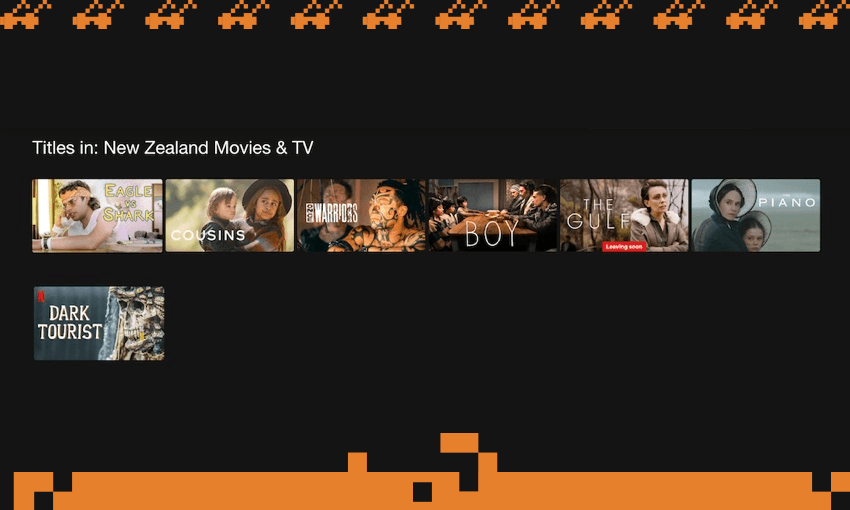SPADA, the screen producers guild, is launching a campaign that seeks to make streaming giants pay a levy on their local revenue. If successful, see a shift in the amount of local content we see on the likes of Netflix and Amazon Prime.
This article first ran in The Spinoff’s weekly pop culture newsletter Rec Room. Sign up here.
New Zealand’s screen production industry has a vast, unruly population. It contains overlords like James Cameron, Taika Waititi, Sir Peter Jackson and Dame Fran Walsh. It also contains thousands of actors, cinematographers, location scouts and wardrobe assistants who work gig to gig and rely on the volume and scale of productions here to make rent.
To interact between the overlords, the big productions and those who staff them, it’s organised into guilds, a mediaeval-sounding term for what are functionally unions representing different aspects of the business. The most prominent and vocal is probably SPADA, which represents screen producers. They’re the people who put TV shows and movies together, organising everything from finance to crew and problem-solving everything in between. My humble advice: if you want anything done in this world, hire a producer. The Spinoff is run by one, and much the better for it.
One of the big challenges for the screen production sector here has been the shift of viewing habits from analogue TV channels like TVNZ1, Three and Sky to streaming platforms like Netflix, Disney+ and Amazon Prime, along with UGC platforms like YouTube and TikTok. As the TVNZ-supplied chart above shows, they have collectively swallowed a vast amount of the attention and corresponding advertising revenue that once funded local productions. While there is a bedrock of consistent money through NZ on Air, Te Mangai Pāho and the NZ Film Commission, shows and movies outside that system are dwindling. The impact of that on what we watch is pretty stark. TVNZ+ (364) and Three Now (81) combine for almost 450 local productions available to stream right now. The equivalent number for Netflix, by far the most popular streamer in New Zealand? Seven, with an average release year of 2008.
That’s what has prompted SPADA to head to the incoming government to demand a levy on streamers to be distributed back into the industry through the funding agencies. Their opening bid is around 5%, which some rough maths suggests could bring in around $11m per year into a sector that is suffering through both a tough macroeconomic climate and the prolonged impact of the still-live actors’ strike. It would also mean that there is a small but hopefully growing supply of original local productions on international streaming platforms, exposing local and global audiences to our voice.
I spoke to SPADA president Irene Gardiner about the idea and why she feels its time is now.
The following transcript has been edited for clarity and brevity
Rec Room: Tell us about the levy and why you need it.
Irene Gardiner: What we’re proposing is that the international streamers operating in New Zealand have a levy put on their New Zealand revenue that is then invested back into local productions via our three funding agencies. Quotas, which is another way that some other countries are going on this, are very tricky because of the trade agreements that we have.
How have the streamers responded to the idea internationally, whether it’s operating or proposed?
I mean, this is happening around the world – New Zealand is a little slow off the mark. The streamers have pushed back, and they will push back because in the end they’re businesses. But at the heart of all this is the fact that they operate in New Zealand. They don’t pay any local tax*. They use our broadband infrastructure, which was partially paid for by New Zealand taxpayers. They don’t have any broadcasting regulations. And as everyone knows, they have been really devastating for viewership of the traditional free-to-air local broadcasters.
What are the impacts of that transfer of viewership and revenues from local companies like TVNZ and Three, to the likes of Netflix, YouTube and Disney+?
Things are pretty challenging out there at the moment because the impact of the streamers has been gradually taking away viewership and therefore ad revenue. Historically, some of that was ploughed back into local production. That’s been compounded a bit of late because of the economy.
The New Zealand screen industry contributes about $3bn a year to the New Zealand economy, and about a billion of that is production. Those millions of dollars are largely brought here by international, but you have to have a strong domestic industry. You don’t get one without the other. The other side is the cultural – the loss of the New Zealand voice, New Zealand stories, New Zealand accent, New Zealand humour. Which, at a time when there is a lot of societal division, becomes very important.
There is an argument that screen is the most privileged sector in the country in terms of funding and rebates. What would you say to the incoming government, whose response might be, ‘not you again’?
We’re not asking for any money. We’re asking for the government to do some work to get our industry some money. So we would hope that that would be well received because this is a business initiative. It’s actually bringing more money into our industry.
* Not strictly true, but the tax paid per dollar earned by the streamers is risible compared to local businesses.



